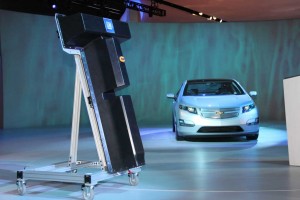Potential buyers seem to be steering clear of the Chevrolet Volt in the wake of reports that the plug-in hybrid experienced several fires following federal crash tests – which could pose a serious problem for General Motors as it prepares for a sharp ramp-up in production for 2012.
Meanwhile, a House panel has scheduled a hearing next month to look into the safety of the Chevy Volt – and the way the Obama Administration has handled the investigation so far. The nation’s top transportation official, despite three fires involving the Volt after testing, has declared the plug-in “safe to drive.”
Separately, GM is reportedly studying changes to the Volt’s battery pack to prevent the possibility of fire after a crash. Such a fix could be announced in a matter of weeks, according to the Detroit Free Press.
The crisis began last month when the National Highway Traffic Safety Administration first reported that a Volt it had subjected to a side-impact crash test in May caught fire three weeks later. Another series of tests last month resulted in a second fire, with a third battery sputtering and smoking.
GM officials told TheDetroitBureau.com that it appears NHTSA did not follow advised protocol after the tests. Though the gas tank was drained the battery was left charged and, they believe, over time, the normally inert coolant went through a chemical change that, as it leaked out of the damaged battery case, caused a short circuit that led to the fires.
Both federal regulators and GM both note that there have been no reports of fires involving a Chevrolet Volt other than following the crash tests. But the headlines have nonetheless taken a serious toll.
A new survey by CNW Marketing shows “a decline in the consideration of the GM vehicle,” according to CNW President Art Spinella. Among early adapters, the research firm saw a 20.5% decline in those “Likely” or “Very Likely” to purchase a Volt between July and December 2011, the latter poll taken after the first reports of a Volt fire. Among general consumers the decline was twice as large.
Only so-called EV enthusiasts remained relatively loyal to the vehicle – which is designed to permit motorists to drive more than 30 miles per charge and then continue driving once the battery is drained by firing up an internal combustion engine.
That could prove a serious setback for GM’s ambitious sales targets for the battery vehicle. Volt was expected to generate 10,000 sales this year, though unless it has a huge burst of demand – countering the CNW survey – in December it will likely miss that mark by about 20%. For 2012, GM has laid out plans to produce 60,000 plug-ins – including a small number of Opel Amperas earmarked for Europe, China and some other overseas markets – with 75% targeted at the U.S.
The maker has engaged in an aggressive damage control campaign. Among other things, it has offered to provide loaners to consumers worried about fire – or to even buy back Volts from owners now uncomfortable with the vehicle. So far, the maker says it has received “a few dozen” such requests.
GM has meanwhile broadcast a revised protocol for handling the battery car after an accident that might have damaged the lithium-ion battery pack. It calls for “de-energizing,” or discharging the battery to reduce the prospect of a fire. Lithium is a highly reactive chemical that can burn at temperatures of over 1,000 degrees, though Volt battery supplier LG Chem claims it has taken steps to reduce the prospect of such fires.
According to a report in the Detroit Free Press, GM may be just weeks away from coming up with a modified battery pack that would further reduce risk. The paper says the maker is studying ways to reinforce the battery to reduce the risk of damage. Changes may be made to the circuitry in the battery, as well, according to a separate report in Reuters.
The Volt fires have ignited a debate on Capitol Hill, meanwhile, House Republicans questioning the handling of the issue by NHTSA, which waited until November to confirm the first incident and then run additional crash tests.
The agency has since launched a formal investigation – which may or may not eventually lead to a recall – but Ray LaHood, the U.S. Dept. of Transportation Secretary, told Congress, “I believe the Volt is safe to drive,” during a separate hearing.
The House Oversight and Government Reform Committee nonetheless plans to hold a hearing in January on the Volt fires and NHTSA’s oversight of the potential problem.
“This is a serious situation that our committee will look further into,” said Jim Jordan, the Ohio House member in charge of the committee. “It gives us great concern that recent reports indicate important safety information may have been omitted in testimony before our committee just a few weeks ago.”
For his part, LaHood says his agency is “not in the business of protecting the auto industry,” despite some claims that it might have held back on the Volt because of the government’s current stake in General Motors – which it took as part of the maker’s 2009 bankruptcy bailout. “We’re in the business of making sure cars are safe,” the DoT chief insisted.


